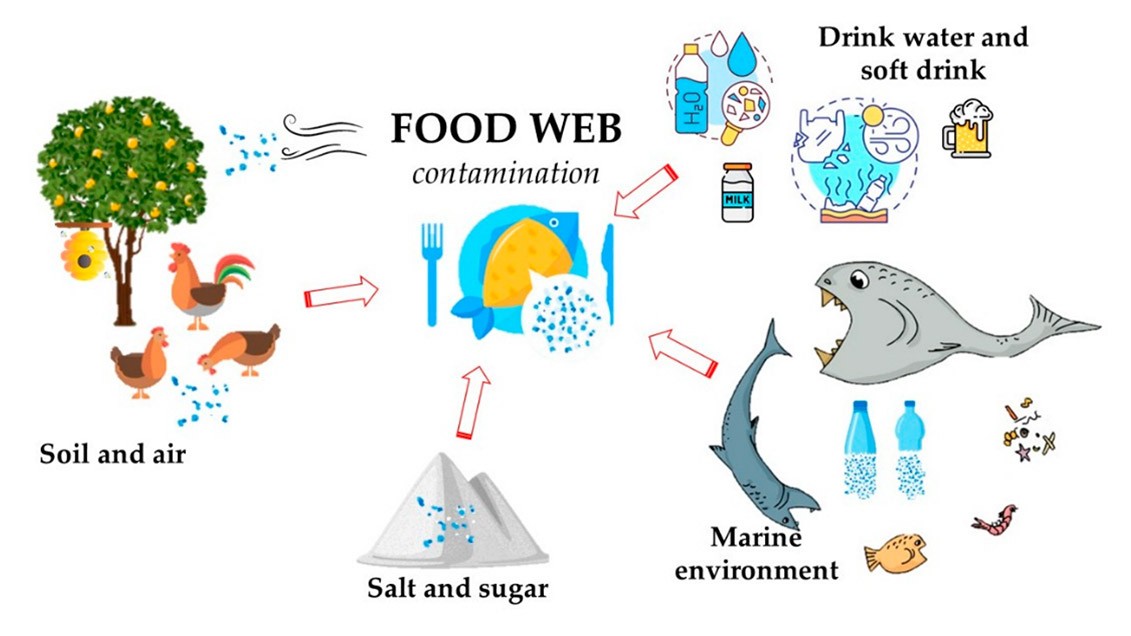Pollution is a word we’ve grown used to—air, land, and water contamination have long been at the centre of environmental discussions, government policy, and global campaigns. However, while much of the public is familiar with large-scale plastic waste, microplastics are a less visible but equally harmful form of pollution that continues to slip under the radar.

Visual from MDPI portrays how microplastics can enter the food chain, affecting seafood safety and potentially human health.
Microplastics are plastic fragments smaller than 5 millimetres. They come from the breakdown of larger plastic items and are also found in everyday consumer products, such as personal care items. Despite their size, their impact is significant, particularly in Malaysia, where fisheries and tourism are key economic drivers.A team of researchers led by Dr. Choo Wou Onn, senior lecturer at the Faculty of Data Science and Information Technology at INTI International University, has conducted a comprehensive review of microplastic pollution in Malaysia. Their findings reveal just how widespread—and underreported—this issue has become.

Dr. Choo Wou Onn, senior lecturer at INTI International University, emphasised that microplastic pollution poses a severe threat to marine ecosystems, including the diverse and rich marine life found in Malaysia’s waters.
Field studies at locations such as Kuala Nerus and Kuantan Port found microplastic particles numbering in the hundreds and thousands. The primary sources are single-use plastics and poor waste management. These include plastic bags, bottles, cigarette butts, and synthetic textiles. The consequences are clear—marine animals are being injured, poisoned, and in many cases, killed.
“Microplastic pollution poses a severe threat to marine ecosystems, including the diverse and rich marine life found in Malaysia’s waters,” said Dr. Choo and his team. They also warned of the broader economic impact: “Malaysia’s economy is closely linked to its marine resources through fisheries and tourism.”
The review explores what can be done to reduce the problem. On the technology front, the researchers highlight improvements in microplastic detection methods, wastewater treatment systems, and advanced filtration techniques. “Cutting-edge technologies such as nanotechnology are leading the way by offering innovative solutions to detect, remove, and remediate these tiny pollutants,” the researchers noted.
But technology alone isn’t enough.
Malaysia has seen early gains through policies like the plastic bag ban, which has reduced usage by 30% and contributed to lower levels of microplastics in the sea. The researchers believe these policies must now be expanded and more strictly enforced. Government intervention remains a critical piece of the puzzle.
Equally important is public awareness. The team cited the UK as an example, where awareness campaigns led to a 30% increase in public concern and, ultimately, greater public participation in tackling plastic waste. Malaysia, they argue, can follow a similar path.
The study calls for a three-pronged approach: advancing technological solutions, strengthening policy and enforcement, and investing in public education and engagement. Addressing microplastic pollution is not just about protecting marine life—it’s about safeguarding public health and sustaining Malaysia’s coastal economy.
This research adds weight to ongoing national discussions on environmental sustainability. By tackling real-world issues through scientific investigation, it contributes practical insights that support policy development and public understanding, demonstrating the value of academic work beyond the classroom.